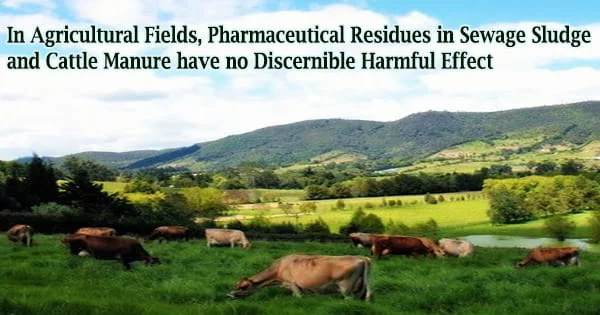According to 14-year-long tests by the University of Copenhagen, pharmaceutical residues and chemicals from personal care items in sewage sludge and bovine manure had no discernible detrimental effect on nematodes living in agricultural areas.
Simultaneously, manure and sewage sludge improve soil quality more than traditional mineral fertilizers and can help to promote more sustainable, circular agriculture. Organic fertilizers such as sewage sludge and cattle dung can help to promote more circular and sustainable agriculture while also preventing soil fatigue.
However, numerous EU nations have banned or restricted the use of sludge in agriculture due to concerns that pharmaceutical and personal care product residues in these types of fertilizers will damage soil.
This worry explains why so many organic farmers in Denmark are skeptical. In Denmark, it is permissible to use biofertilizers, which are treated sewage sludge that has been tested for heavy metals and other contaminants.
In Denmark, however, pharmaceutical residues and the majority of personal care product ingredients are not examined. A new study from the University of Copenhagen shows that pharmaceutical and household chemicals can be detected in sludge-fertilized soil, but the amounts are minimal for the biological parameters studied.
Sludge and manure, on the other hand, improve soil quality substantially more than standard mineral fertilizers.
“We expected to find a lot of pharmaceutical residues in the soil which is why the use of sludge is prohibited in many countries. And we also hypothesised that these residues might stay in the soil and become problematic for soil organisms. The latter doesn’t seem to be the case,” says professor and lead author Nina Cedergreen from the Department of Plant and Environmental Sciences.
It is unique for a research project to apply fertilizer to the same tract of soil for 14 years and in extreme quantities for most years. So, if the chemicals were to have accumulated and have a toxic effect, one ought to have been able to see it after so many years. But there is nothing to note when we measure the well-being of the worms. The pharmaceutical residues are probably broken down in time, as there is so much biological activity in the soil.
Jeanne Vuaille
The researchers determined soil quality using physical features as well as the number and reproductive capacity of nematodes in the soil, which are known bioindicators of soil health. PhD fellow and first author Jeanne Vuaille elaborates:
“The small worms grow and reproduce significantly better in the soils that receive sludge and manure than in those where conventional fertilizers are applied. The soil has better structure, a higher carbon content and greater humidity. At the same time, we see no toxic effect on the worms from the pharmaceuticals and personal care chemicals that we were able to measure in the soil. This is most likely because their concentrations were incredibly small.”
Fourteen years of experimentation
The case study research is based on fourteen years of experimentation. The experimental fields in Taastrup have been fed with various forms of organic matter and standard NPK fertilizers over the years by University of Copenhagen researchers directed by Associate Professor Jakob Magid.
To assess the worst-case scenarios, sewage sludge and cattle manure were added in amounts four times higher than allowed by Danish legislation.
“It is unique for a research project to apply fertilizer to the same tract of soil for 14 years and in extreme quantities for most years. So, if the chemicals were to have accumulated and have a toxic effect, one ought to have been able to see it after so many years. But there is nothing to note when we measure the well-being of the worms. The pharmaceutical residues are probably broken down in time, as there is so much biological activity in the soil,” says Jeanne Vuaille.
The researchers discovered twelve different chemicals originating from various medications and personal care products in soil fertilized with sewage sludge, which is consistent with prior findings.
Painkillers, antidepressants, heart medications, and perfume remnants were among the chemicals found. None of these compounds were found in the routinely fertilized crops, as expected. The nematodes did, however, do better in the organically enriched soil.
“We need a new narrative”
The researchers note that the findings alone do not guarantee that employing sewage sludge and animal manure in agricultural fields poses no environmental problems.
As a result, the researchers expect that this study will pave the way for additional research to back up their conclusions. Fluorinated compounds, which can also be found in sewage sludge, are currently receiving a lot of attention.
“A range of substances are present in organic fertilizers. Therefore, we need to look at all of the potential risks associated with using it and hopefully demonstrate that they are minimal when compared to the many benefits. Right now, sludge has been branded as a “bad” type of fertilizer by some. So, we need a new narrative about organic fertilizer from cities for it to gain social acceptance,” says Nina Cedergreen, who continues:
“If we are to move society toward a circular economy and sustainability, we need to find a way to replace the soil nutrients that we remove when harvesting crops. And ideally, with minimal use of conventional fertilizers, which are energy-intensive and expensive to produce. This is currently not the case. But it’s where we ought to be headed. Otherwise, we will exhaust our soils, as has occurred many places on Earth.”
Other experiments in the same experimental fields are now being conducted at the University of Copenhagen. These studies look at how organic fertilizer influences plant growth and how well chemicals found in soils may be absorbed by crops, among other things.
















